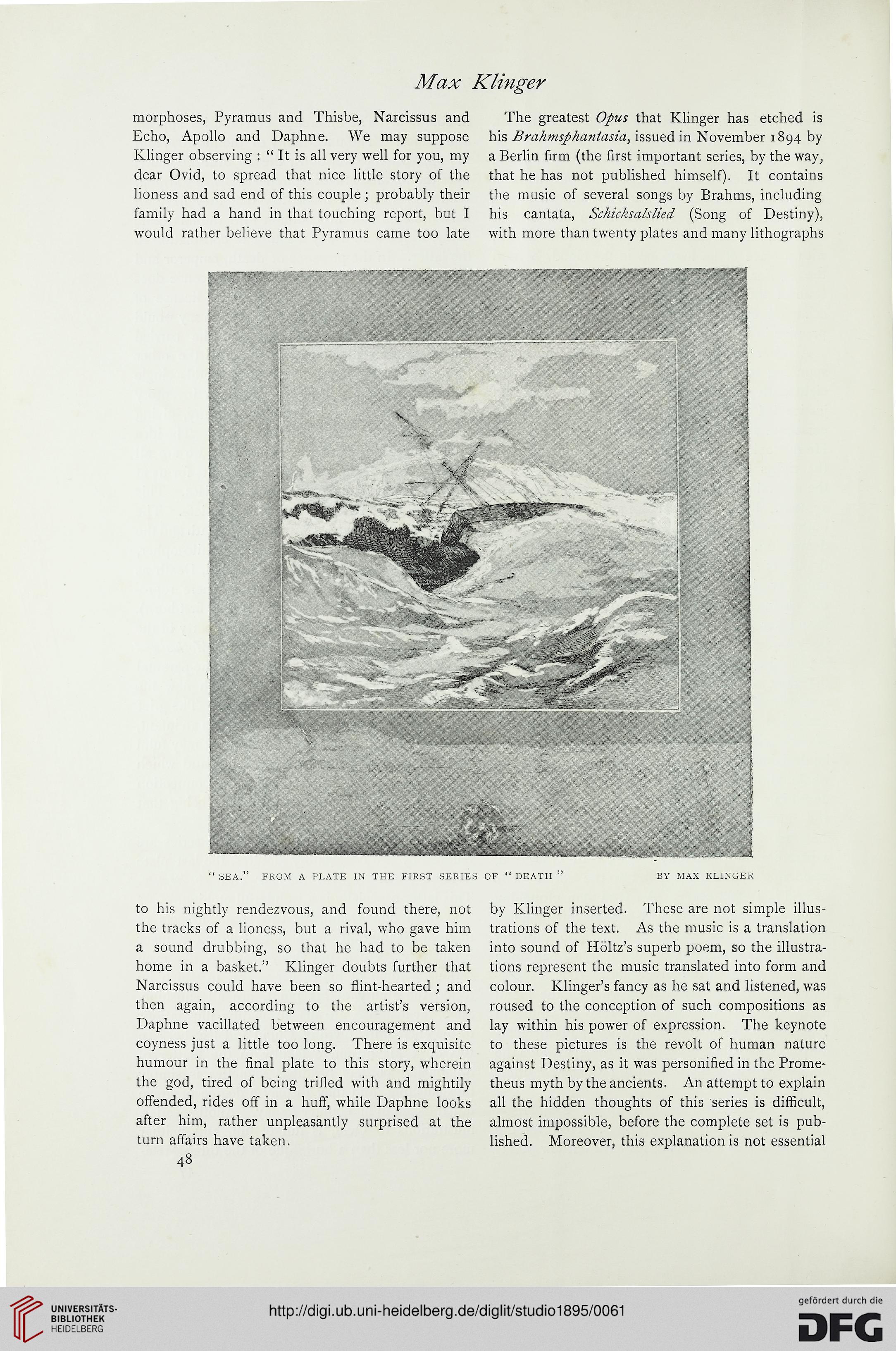Max Klinger
morphoses, Pyramus and Thisbe, Narcissus and The greatest Opus that Klinger has etched is
Echo, Apollo and Daphne. We may suppose his Brahmsfihanlasia, issued in November 1894 by
Klinger observing : " It is all very well for you, my a Berlin firm (the first important series, by the way,
dear Ovid, to spread that nice little story of the that he has not published himself). It contains
lioness and sad end of this couple; probably their the music of several songs by Brahms, including
family had a hand in that touching report, but I his cantata, Schicksalslied (Song of Destiny),
would rather believe that Pyramus came too late with more than twenty plates and many lithographs
" SEA." FROM A PLATE IN THE FIRST SERIES
to his nightly rendezvous, and found there, not
the tracks of a lioness, but a rival, who gave him
a sound drubbing, so that he had to be taken
home in a basket." Klinger doubts further that
Narcissus could have been so flint-hearted ; and
then again, according to the artist's version,
Daphne vacillated between encouragement and
coyness just a little too long. There is exquisite
humour in the final plate to this story, wherein
the god, tired of being trifled with and mightily
offended, rides off in a huff, while Daphne looks
after him, rather unpleasantly surprised at the
turn affairs have taken.
48
OF " DEATH " BY MAX KLINGER
by Klinger inserted. These are not simple illus-
trations of the text. As the music is a translation
into sound of Holtz's superb poem, so the illustra-
tions represent the music translated into form and
colour. Klinger's fancy as he sat and listened, was
roused to the conception of such compositions as
lay within his power of expression. The keynote
to these pictures is the revolt of human nature
against Destiny, as it was personified in the Prome-
theus myth by the ancients. An attempt to explain
all the hidden thoughts of this series is difficult,
almost impossible, before the complete set is pub-
lished. Moreover, this explanation is not essential
morphoses, Pyramus and Thisbe, Narcissus and The greatest Opus that Klinger has etched is
Echo, Apollo and Daphne. We may suppose his Brahmsfihanlasia, issued in November 1894 by
Klinger observing : " It is all very well for you, my a Berlin firm (the first important series, by the way,
dear Ovid, to spread that nice little story of the that he has not published himself). It contains
lioness and sad end of this couple; probably their the music of several songs by Brahms, including
family had a hand in that touching report, but I his cantata, Schicksalslied (Song of Destiny),
would rather believe that Pyramus came too late with more than twenty plates and many lithographs
" SEA." FROM A PLATE IN THE FIRST SERIES
to his nightly rendezvous, and found there, not
the tracks of a lioness, but a rival, who gave him
a sound drubbing, so that he had to be taken
home in a basket." Klinger doubts further that
Narcissus could have been so flint-hearted ; and
then again, according to the artist's version,
Daphne vacillated between encouragement and
coyness just a little too long. There is exquisite
humour in the final plate to this story, wherein
the god, tired of being trifled with and mightily
offended, rides off in a huff, while Daphne looks
after him, rather unpleasantly surprised at the
turn affairs have taken.
48
OF " DEATH " BY MAX KLINGER
by Klinger inserted. These are not simple illus-
trations of the text. As the music is a translation
into sound of Holtz's superb poem, so the illustra-
tions represent the music translated into form and
colour. Klinger's fancy as he sat and listened, was
roused to the conception of such compositions as
lay within his power of expression. The keynote
to these pictures is the revolt of human nature
against Destiny, as it was personified in the Prome-
theus myth by the ancients. An attempt to explain
all the hidden thoughts of this series is difficult,
almost impossible, before the complete set is pub-
lished. Moreover, this explanation is not essential




